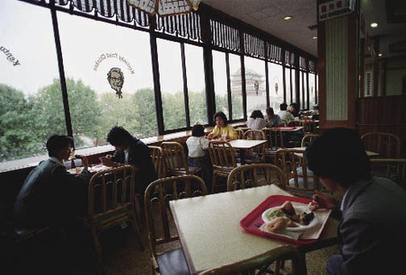|
Farewell to Coarse Grain and the Rise of Health Products
 |
| On November 12, 1987, the first KFC outlet opened in Qianmen, one of the busiest districts in Beijing. |
In the 1980s, per capita annual grain production reached 400 kg, ending the history of grain shortages in China. China feeds 22 percent of the world's population with seven percent of the world's arable land.
But in the early 1980s food was still in short supply, and food coupons reached their zenith. Besides food and cooking oil coupons, there were coupons for pork, beef, mutton, chicken, duck, fish, eggs, sugar, bean curd products and all kinds of vegetables. Food grain coupons included those for rice, wheat flour, coarse grain, millet and potatoes. The many varieties of coupons were related to the diversification of available food.
Zhu Guangrong, who worked in Beijing's foodstuff industry, recalls that at that time there were long queues in front of every food counter. Even frozen fish and expired candies were valuable supplies that people bought without complaint. So-called "high-grade candies and pastries" were ordinary fruit drops and walnut cookies, priced at RMB 10 per kilogram. The monthly salary for an ordinary wager-earner was RMB 40-50, but these hot items were in great demand.
On weekends or at the end of the month, food grain shops were the busiest places and long lines of customers would snake out of every door. Food grain stations were responsible for the neighborhood grain supply. According to regulations, inhabitants were only allowed to buy grain in their assigned shop. If they moved to another neighborhood, they had to transfer their "food relations." When people went on business trips or visited other parts of the country, they were allowed to change a certain amount into "universal food coupons" by showing a certificate issued by their workplace, so they could buy food in other localities.
With economic reform in rural areas, China's grain output continually increased. In 1985 the state monopoly was relaxed and grain distribution reformed. As well as using food coupons to buy grain, people could purchase grain at a "negotiated price," usually double the coupon rate. More and more food items could be purchased without coupons, so people had more and more disposable coupons and could trade them for other commodities. For example, people could swap a 3-kg grain coupon for one kilogram of eggs, or a 20-kg universal food coupon for a small aluminum basin.
The difference between the low fixed prices and the "negotiated" prices placed a heavy burden on the government, while the non-transferable nature of most food coupons hindered the population flow. In 1993, the Chinese government abolished food coupons altogether, and lifted price controls over grain. From that time on, rural inhabitants began eating fine grain (usually wheat flour and rice) as their staple food.
In the mid-1980s China carried out the "Vegetable Basket" project, aiming to solve shortages of poultry, eggs, milk, fruits and vegetables. Through efforts over nearly a decade, supplies of non-staple foods were greatly improved. The market flourished in terms of both supply and demand, and prices were stable. By 1999, China became the world's largest producer of meat, eggs and aquatic products, and the annual per capita consumption rate increased to five to 15 times that of the years before reform and opening-up. Coarse grain gradually disappeared from people's dinning tables and fine grain became the main staple food. An unprecedented variety of vegetables and fruits became available. Chicken, duck, fish and meat, all of which used to appear on people's dining tables only during festivals, became commonplace. Chinese people's diet began to change from one of subsistence to one of comfort and choice.
|
